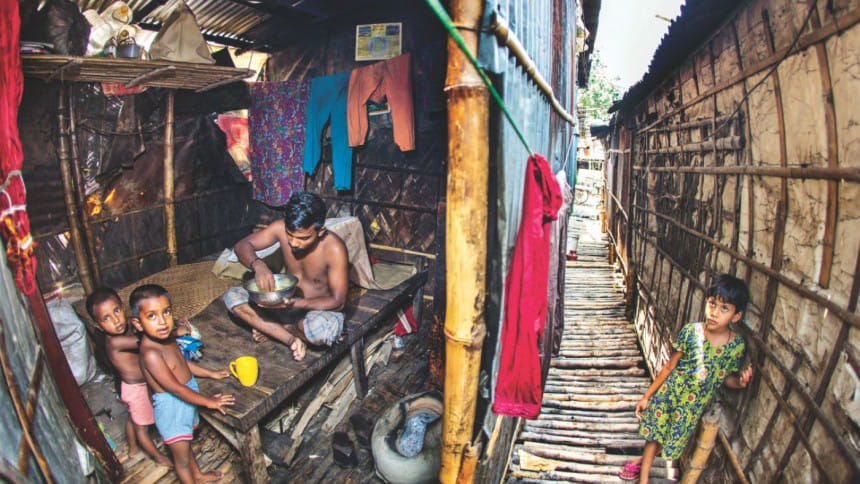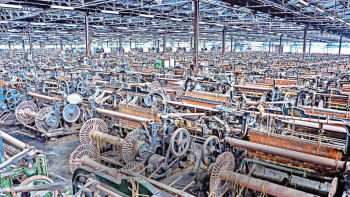Urban Poor: Caught in cycle of misfortune, debt, neglect

Rokeya Begum's family lived off paddy farming in Bajitpur upazila of Kishoreganj. Three years ago, adverse weather damaged their crops, leaving them with nothing to subsist on.
Looking for a living, she came to Dhaka with her husband, Raihan Uddin, and elder son. But before they could start anew at a slum in the capital's Meradia, Raihan fell sick and was diagnosed with TB. Bedridden, he shelved his plan for setting up a tea stall.
Rokeya began working as a maid, but the income was too little even to pay for food and the one-room house they rented. She was worried sick thinking how she would buy Raihan's medicines and repay the Tk 35,000 microloan they took to farm their land.
So she borrowed money from better-off people at the slum at 100-120 percent interest rate to buy food and medicines for Raihan. Back in the village, her in-laws took care of the microloan and her two other children.
“That's our fate…. When one lender pesters us, we borrow from another to pay him back,” says Rokeya sitting in a 10-feet-by-10-feet room in the slum as she explains why she has not yet made it out of the cycle of debt.
Her story reflects the misery of many slum dwellers who come to cities looking to leave behind the hardship because of social and economic shocks or environmental consequences.

They do find a place into the world of flashing lights and busy streets, but their lives don't get any easier because of the high living cost and the absence of basic social and government protection.
Of the yearly influx of urban migrants, five to seven lakh people come to the capital, according to Unicef.
Some 70 percent of them come here having fallen victim to environmental disasters like flood, cyclone, river erosion and crop loss due to untimely rain, according to the International Organisation for Migration.
URBAN POOR WITHOUT SOCIAL PROTECTION
Most of these migrants comprise the working class, but the government doesn't recognise their contribution to the economy, said Ashekur Rahman, urban programme specialist at the UNDP Bangladesh.
Those of the urban poor, who live in slums across the country, have increased by more than 60 percent to 2.23 million in the last 17 years. Almost half of them live in Dhaka division alone, according to the Bangladesh Bureau of Statistics.
In the capital, a majority of the poor live mostly in illegal infrastructures built on Khas land by locally influential people, who also provide them with illegal water and electricity supply at a high cost.
There is a huge gap between social and government services available to rural and urban poor. Policymakers don't even consider ensuring basic rights like education and primary health of the poor people living in cities.
“Slum dwellers live like refugees. The city corporations and other government service providers don't consider them the city's residents,” Ashekur said.
For example, he said, in the capital's Korail, there are not enough public schools for the children living in the slums there.
Some NGOs are working to improve the water, electricity and sanitation situations, but that's on a temporary or ad hoc basis.
The government's intervention is very rare, which is indeed necessary to make a big impact, said Prof M Abu Eusuf, chairman of development studies department at Dhaka University.
After crop loss due to sudden flash floods in the northern districts only late last month, many farmers have been reported to have left their villages for work in nearby cities.
Rokeya's life exemplifies the financial constraints that push these people to migrate to cities and the consequences they face.
The 35-year-old is surely among the extreme urban poor estimated at 7.7 percent in 2010, down from 14.6 percent in 2005, by the Bangladesh Household Income and Expenditure Survey (HIES). During the same period, the number of urban poor fell to 21.3 percent from 28.4 percent. More recent data is not available.
Though there has been a significant improvement in the poverty status in urban areas, a Unicef report says climate change threatens to reverse some of Bangladesh's success in primary education, healthcare, child marriage, child labour, hunger and malnutrition.
This concern seems real when seen in the context of the lives of slum dwellers like Rokeya and Raihan.
With empty hands, the couple came to Dhaka leaving their five-year-old son and 12-year-old daughter to be cared for by Raihan's parents. The daughter was married off the same year, for which Rokeya is “grateful” to her in-laws.
Given his health condition, Raihan is unable to support the family much, though he sometimes pulls rickshaw or sells peanuts on the streets.
Rokeya's monthly income of Tk 2,300 cannot even pay the house rent, and so her son, aged only 14, shoulders the family's responsibility.
Globally, poverty is defined by income of $1.9 or below per person per day, but life in a village and a city can be two poles apart with the same income.
Migrants may see a significant income rise when they move to cities from rural areas, but that fails to improve their living standards because of high living cost.
“There is a misconception among policymakers that poverty can be eradicated only by addressing rural poverty,” Ashekur said.
There are many government programmes aimed at encouraging the poor migrated population to return to their villages. But those have not been much of a success because economic activities have not increased in rural areas in proportion to the overall economic development, he added.
LACK OF SAFETY NET FOR URBAN POOR
To lift people out of extreme poverty in rural areas, the government has taken many initiatives like tagging microcredit programmes with social safety net programmes. Some have been successful.
One such project -- Income Generation for Vulnerable Group Development (IGVGD) Programme -- was taken up and coordinated by the government, World Food Programme and Brac in 1985.
Under the programme, widowed and abandoned women are given free food grains as well as some credit at the end of six months' training. The food support continues for 18 months, by which time they start making a steady income with the loan money.
Such an approach helps the ultra poor to leave behind their bleak present and give them hope for a better future, as studies by NGOs, Palli Karma-Sahayak Foundation and Brac Development Institute suggest that the bottom 10 percent of the country's population don't have access to microcredit.
Currently, about 10 percent of the urban poor are under social safety net programme against 30 percent in rural areas, according to the latest HIES report.
Except for Open Market Sale and Urban Community Development programme meant for the urban poor only, other safety net programmes cover mostly rural areas -- 94.03 percent old-age allowance and 98.32 percent of the allowance meant for widowed and distressed women go to the rural poor, said Prof Eusuf, citing Planning Commission data from 2015.
Recently, the government has adopted a more inclusive National Social Security Strategy to address poverty and inequality. But the DU teacher warned that policymakers must keep in mind that the need of the urban poor is very different from that of the rural poor.
Urban poverty is an ever increasing crisis, but no policy has been formulated to tackle it, the DU teacher said.
“The government thinks if the issues of urban poverty are addressed, the poor will be encouraged to migrate to cities, which is wrong.”
Globally, migration has remained one of the popular livelihood strategies. So, if the middleclass can move to cities looking for better jobs, the poor should also have the right to move to urban areas for a living.
That's what Sabina Begum did seven years back.
Her family moved to Dhaka from Nasirnagar upazila of Brahmanbaria when she and her husband were struggling to repay the loans they had taken to buy food for their children -- a toddler and an infant.
Her village Goalgor is surrounded by rivers. Farmlands in the village remain under water half of the year. People mostly do fishing for living.
“The income was low and so we came here,” Sabina says.
The first few years went well. With her income from sewing and work as house help and her husband's from construction job, they paid off the loans.
But then her husband's developing asthma came as a fresh blow to the family and the whole financial burden fell on her.
To break the cycle of falling into a crisis and then recovering, she took a gamble this time.
She decided to send her husband to Oman after one of the house owners she worked for promised to arrange a decent job for him.
She borrowed Tk 90,000 from two local people before her husband flew to Oman in January. Sabina needed the money for applying for her husband's passport, medical check-up and plane fare.
She promised to repay the loan, including the interest of Tk 45,000, by July. Four months have gone but her husband could send only Tk 30,000.
Sabina says her idle days are spent worrying. She is now thinking of taking loan from a centre of ASA, a microcredit organisation, in the village on the pretext that she would invest the money in poultry farming.
“Still, if he doesn't send enough money, how will I manage?”
Sabina now wants to return to Dhaka to work, but fears for her safety in one of those clustered shanties in Bhasantek slum she lived in before.
Like her, slum dwellers face constant social and financial threats, but the authorities hardly notice their ordeals.

 For all latest news, follow The Daily Star's Google News channel.
For all latest news, follow The Daily Star's Google News channel. 



Comments